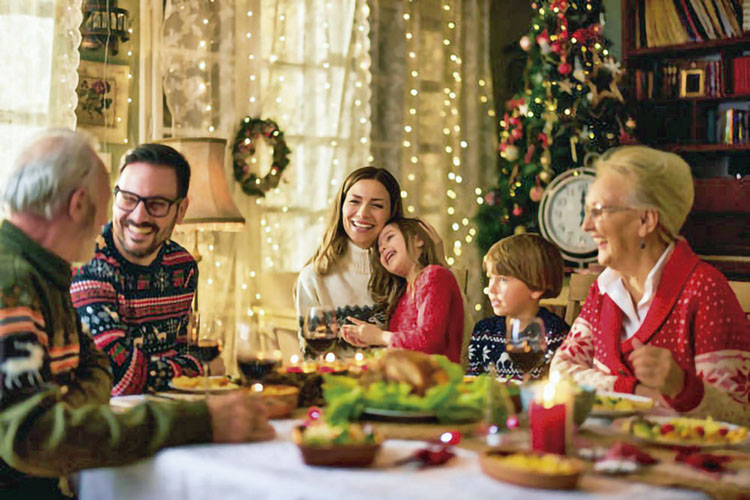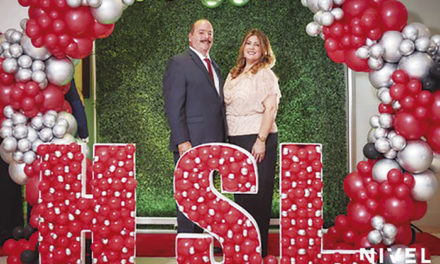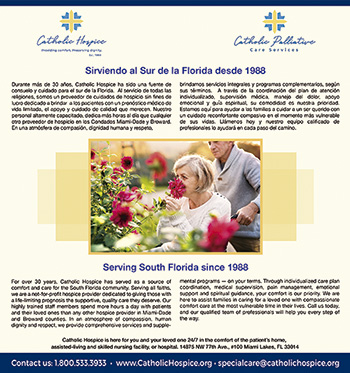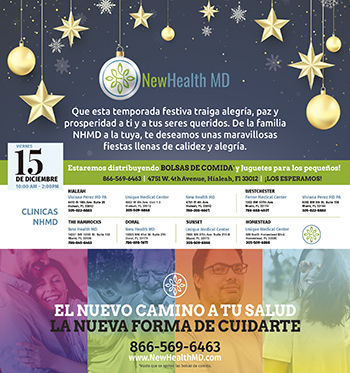Jesus Hernandez
December is Christmas, when Miami dresses in colors and decorates streets and balconies waiting for the day to either celebrate the birth of Jesus Christ and / or share gifts and have dinners, while we all wait for the arrival of a new year.
In Miami it´s Christmas Eve first, on the 24th, when Hispanics sit at the table to taste their traditional dishes. A festivity that celebrates the culture of the many origins that make up this great city.
“Salt, garlic, sour orange and that’s it,” Susana pointed out proudly when we asked her how she prepares the pork that will preside over the table on Christmas Eve.
Juan, who comes from Nicaragua, brings gallopinto rice, and Carmen, who has deep roots in her native Colombia, speaks with pride about the sweets she prepares with figs in syrup and papaya chonks in syrup as well.
There is Robert, ‘the American’, who did not eat pork before, but after 20 years of marriage to a Cuban woman he enjoys it like anyone else.
“First, I taste it at the work party, when the company organizes the Christmas dinner, and then at home too. If not, my wife will kill me,” he joked with a laugh.
At Christmas day dinner, Susana, to please her American husband, will have “a roast turkey with old fashioned bread stuffing and spices,” in addition to the prawns and appetizers prepared by her neighbor, a Spanish woman who joins this multicultural celebration.
Since the foundation of this city, some 127 years ago, with the arrival of Anglos and African Americans from the north of the country and later the following Hispanic immigrations, Miami became a melting pot of cultures that keeps the roots of its origins alive.
With the many years of exile that have passed for Cubans, the arrival of Nicaraguans, Colombians and 20 other nationalities have made this melting pot of cultures possible, from Opa-Locka and Hialeah to Kendall and Homestead.
“That’s what makes this city great. You can eat Cuban-style roast pork with congrís or Nicaraguan gallopinto, while you enjoy Colombian figs or a good Venezuelan ham bread,” said Carmen, who attends Catholic Mass at midnight to commemorate the arrival of Christmas on the 25th.
Christmas
On the morning of December 25th, when half the city is resting, after a long party the night before, the kids run to the Christmas tree in search of their gifts and take photos next to the Nativity of Jesus, which Grandma Belén sets up nicely every year.
Meanwhile, Susana and Robert prepare the Cuban-style pork and the American-style turkey at the same time.
“I like Christmas when it’s cold, like we’ve had sometimes,” claimed Robert, who this year is expecting his brother and family from Tampa. “They don’t speak Spanish either and they always bring an apple pie,” he said.
Meanwhile, the youngest of the family pay attention to the Internet on his cell phone: “You must look for the best prices. There are many special sales,” said Miguel, who at only 15 years old has become an expert at hunting for deals.
End of the day
In the afternoon, when the Sun is about to set, the tables will once again be full of food to celebrate Christmas.
“Do you need some advice?” asked Robert’s sister, who is a nutritionist. “Eat and drink in moderation. If we fill the stomach too much at once, the first thing you will feel is discomfort the next day because you are not used to eating so much.”
“And if you can’t avoid eating or drinking a lot, keep a good glass of milk in hand. “That helps refresh you,” she advised with a laugh.
Then comes December 31, when many of us return to prepare dinners and parties to wait for the 12 bells and eat the 12 grapes of luck for the new year.
In Bayfront Park, as well as in Miami Beach and most cities in Miami-Dade County, music, food, and fireworks mark the arrival of the new year.
History
Historians claim that the Roman Empire celebrated the winter solstice 2,000 years ago with festivals to honor the god Saturn, which lasted precisely until December 25.
Three centuries later, Roman Emperor Constantine established freedom of religion, ending religious persecution, particularly of Christians, which led to the recognition of Christianity.
The Romans continued to celebrate the winter solstice until Christians, led by the Catholic Church in Rome, took the holidays to evoke the birth of Jesus.
A few years earlier, Clement of Alexandria, today venerated by Copts, Orthodox and Anglicans, assured that Jesus was born in May, but Pope Julius I proposed that the birth of Jesus be celebrated on December 25, an initiative that was finally made official by his successor, Pope Liberius, until the holiday of Christmas was spread with evangelization throughout the world.
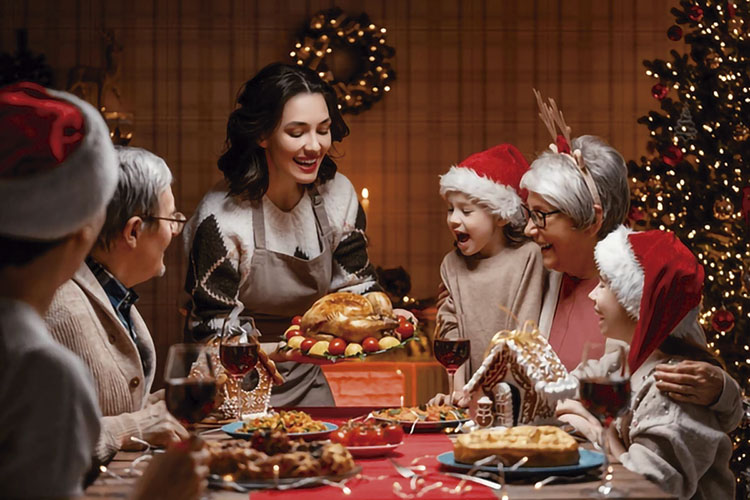
Miami celebra Navidad con su crisol de culturas
Jesús Hernández
Diciembre es sinónimo de Navidad, cuando Miami se viste de colores y adorna sus calles y balcones porque llega el día que muchos celebran el nacimiento de Jesucristo y otros comparten regalos y realizan cenas, mientras esperan el arribo de un nuevo año.
En Miami, primero Nochebuena, el 24, cuando los hispanos se sientan a la mesa para degustar sus platos de temporada. Una fiesta que celebra la tradición cultural del abanico de orígenes que conforma a esta gran ciudad.
“Sal, ajo, naranja agria y ya está”, señaló Susana con orgullo cuando le preguntamos cómo prepara la carne de cerdo que presidirá la mesa la víspera de Navidad.
Juan, que viene de Nicaragua, apuesta por el arroz gallopinto y Carmen, que lleva muy arraigada su Colombia natal, habla con orgullo del dulce que prepara: unas brevas en almíbar y dulce de papaya.
Ahí está Robert, ‘el americano’, que no comía cerdo, pero luego de 20 años de matrimonio con una cubana lo disfruta como cualquier otro.
“Primero lo como en la fiesta del trabajo, cuando la empresa organiza la cena de Navidad, y después en casa también. Si no, mi esposa me mata”, bromeó con una carcajada.
Para la tarde del 25, Susana, para complacer a su esposo el americano, tendrá en casa “un pavo relleno con pan frito desmenuzado y especias”, además de las gambas y los entremeses que prepara la vecina, una española que se une al festejo multicultural.
Y es que, desde la creación de esta ciudad, hace apenas 127 años, con la llegada de anglos y afroamericanos del norte del país y las posteriores inmigraciones hispánicas, Miami se convirtió en un crisol de culturas que mantiene vivas las raíces de sus orígenes.
Con los tantísimos años de exilio que han transcurrido para los cubanos, la llegada de nicaragüenses, colombianos y 20 nacionalidades más han hecho posible la amalgama cultural, desde Opa-Locka y Hialeah hasta Kendall y Homestead.
“Eso es lo que hace grande a esta ciudad, que lo mismo come puerco asado al estilo cubano con arroz congrís o gallopinto nicaragüense, que disfruta unas brevas colombianas o un buen pan de jamón venezolano”, señaló Carmen, que acude a la Misa del Gallo, a la medianoche, que conmemora la llegada de Navidad el 25.
Navidad
El 25 de diciembre, cuando media ciudad parece descansar, después de una larga noche de manjares y bebidas alcohólicas, los más pequeños corren hacia el árbol de Navidad en busca de sus regalos y se hacen fotos junto al Nacimiento de Jesús, que la abuela Belén coloca allí cada año.
Entretanto, Susana y Robert preparan el cerdo a la cubana y el pavo a la americana por igual.
“Me gusta la Navidad con frío, como hemos tenido a veces”, reclamó Robert, que este año espera a su hermano y familia de Tampa, “que tampoco hablan español y siempre traen un pastel de manzana”.
Mientras, el más joven de la familia está pendiente de internet en su teléfono celular: “Hay que buscar los mejores precios. Estos días hay muchas ventas especiales”, comentó Miguel, que con solo 15 años se ha hecho un experto en cazar ofertas.
Fin del día
En la tarde, cuando el Sol esté a punto de bajar, las mesas volverán a estar repletas de comida para festejar Navidad.
¿Consejos? “Muchos”, aseguró la hermana de Robert, que es nutricionista. “Comer y beber con moderación. Si llenamos mucho el estómago de una vez, lo primero que va a sentir es malestar al otro día porque no está acostumbrado a ingerir tanto”.
“Y si no puede evitar comer o beber mucho, tenga a mano un buen vaso de leche fresca. Eso ayuda a refrescar”, aconsejó entre risas.
Luego viene el 31 de diciembre, cuando muchos vuelven a preparar cenas y fiestas para esperar las 12 campanadas y comer las 12 uvas de la suerte para el nuevo año.
En Bayfront Park, así como en Miami Beach y la mayoría de las municipalidades, música, comida y fuegos artificiales anuncian la llegada del año nuevo.
Historia
Cuentan los historiadores que el Imperio Romano celebraba hace 2.000 años el solsticio de invierno con fiestas en homenaje al dios Saturno, que culminaban precisamente el 25 de diciembre.
Tres siglos después, el emperador Constantino estableció la libertad de religiones, dando fin a las persecuciones religiosas, particularmente los cristianos, lo que conllevó al reconocimiento del cristianismo.
Los romanos continuaron celebrando el solsticio de invierno hasta que los cristianos, conducidos por la naciente Iglesia católica en Roma, absorbieron la fiesta para evocar el nacimiento de Jesús.
Unos años antes, Clemente de Alejandría, hoy venerado por coptos, ortodoxos y anglicanos, aseguró que Jesús nació en mayo, pero el papa Julio I propuso que el nacimiento de Jesús fuese celebrado el 25 de diciembre, iniciativa que fue finalmente consagrada por su sucesor, el papa Liberio, hasta que la festividad fue propagada con la evangelización por todo el mundo.

